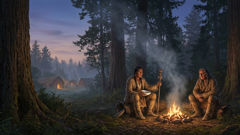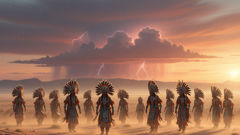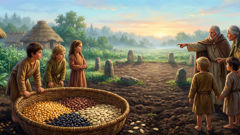Introduction
Long before the maps of settlers and traders, when the fields and rivers carried the slow work of seasons and the great forests spoke in the language of wind and birds, there moved a man known simply as the Peacemaker. His arrival was not heralded by banners or armies; it came like the soft authority of spring thaw, resolute and unavoidable. He crossed territories where old grievances lay like broken arrows along the pathway: families chilled by loss, towns shadowed by revenge, leaders who measured honor by how many enemies they could count. The Great Peacemaker carried no weapon. He carried a message and a bowl made from polished white shell and a staff carved with the shape of a turtle—symbols that would teach a new law. At his side walked Hiawatha, a man whose grief had hollowed him and whose voice would become a bridge between the new law and the stubborn hearts of men and women who still remembered blood and fire. Hiawatha had been defeated by sorrow; three daughters lost to mourning, a household emptied, laughter taken. His silence turned to words under the Peacemaker's patient hand, and what those two made together—counsel, songs, and a Tree of Peace planted among the nations—would be sung for generations. This retelling seeks to honor the spirit of that founding moment: to walk from the riverbanks where negotiations began, into the council fires where speeches rose, past the longhouse doors where families weighed the cost of unity, and through the seasons that taught the new law to hold. It examines the symbolism of the Tree of Peace, the role of the wampum belts as living treaties, and how the Great Law shaped ideas of consent, clan responsibility, and balanced governance. More than a simple chronicle, this narrative is an invitation—to hear the cadence of Hiawatha's voice, to feel the Peacemaker's steady conviction, and to understand how a people turned from cycles of revenge toward a lasting alliance. As we traverse the woodlands of story, remember that legends are not mere tales of the past but guides that communities use to teach values, resolve conflict, and keep memory alive. This is the story of how wisdom and sorrow braided into a covenant that became the Haudenosaunee—the People of the Longhouse.
The Peacemaker’s Walk and Hiawatha’s Sorrow
The Peacemaker arrived in the lands of the five nations without announcement, as if he had always been part of the landscape. He came on a morning when mist lay low in the hollows and deer paths still drank the dew. Trees arched like cathedral ribs over his head; the air smelled of moss and river-silt. He walked with a deliberate calm, the kind that hushes argument momentarily: a presence that demanded attention not by force but by the gravity of conviction. The first person to find him was a woman gathering wood, and with a simple exchange—a bowl offered in respect, a soft-spoken question—the slow work of persuasion began.

Hiawatha met the Peacemaker at a place where the river widened and the current slowed, a natural crossing used for generations. Hiawatha's hands trembled when he took the shell bowl. He was a man both honored and broken: his household had been devoured by the logic of retribution, his daughters taken, his laughter gone from the longhouse. He had once been known for quick counsel and for stories that warmed cold winters; now his words were wary. The Peacemaker did not ask for immediate answers. He offered a story instead—a way to see beyond immediate pain to shared futures. "There is a law I was given," the Peacemaker said, "a way that binds people together rather than splitting them. It will ask things of you that no spear can teach: patience, forgiveness, steadiness. Will you learn it and speak for it?"
Hiawatha's path toward advocacy started in silence and memory. In the first days, he walked beside the Peacemaker and watched how he listened—truly listened—to women who had lost sons, to chiefs who feared loss of honor, to youth who were hungry for a cause. The Peacemaker taught him songs and the use of wampum strings to record promises, but more than that, he taught Hiawatha the economy of speech: how to place a single sentence so it could carry the weight of a year. Hiawatha learned to shape grief into words that others could hold without shattering. Where retaliation had been carved as a reflex, Hiawatha learned to insert a pause and place a question instead. Such was the beginning of his transformation from a man of mourning into a spokesman whose voice would move councils.
Their journey became a pattern of small, altar-like meetings: a clearing where the Peacemaker planted a sapling and spoke of a Tree of Peace; a lakeside where the two braided strings of wampum to show how promises could be kept by seeing them; a hilltop where they taught a song that described the duties of leaders and the rights of people. Each demonstration answered practical fears. The Peacemaker would show how leaders should be chosen not for the number of their war deeds but for their steadiness in council; Hiawatha would recite a line and make it human—naming a mother who would keep her children safe because the chief promised that no clan would steal from another. Where rhetoric threatened to float like smoke, Hiawatha anchored it with stories drawn from the longhouse: a memory of a feast where two cousins reconciled over maize and maple, an account of a hunter who spared a track that belonged to a neighbor. He wrapped abstract laws in the warmth of domestic life, and people who had been taught by memory responded.
Not all encounters were kind. There were war chiefs whose pride had been earned by pain, men who could not see how halting warfare could preserve honor. In a council where the Peacemaker's words had failed to soften a leader's jaw, Hiawatha stepped into the space and told of his own daughters. He did not plead so much as show the cost of continuing on the same path. He spoke of longhouses that closed their doors when enemies passed, of fields left unplanted because young men buried their time in raiding, and of women who had to hold the line of survival without partners. Hiawatha's recounting was honest and surgical; it made listeners feel the toll as if it belonged to them. It is a measure of his skill that he did not demand apology; instead, he asked for a choice: "What will we build that will honor what we have lost?" That question corroded some anger by naming a future one could imagine rather than a past that could not be undone.
As they moved from nation to nation, Hiawatha learned to use the Peacemaker's symbols. The shell bowl—smooth, pale, and unadorned—became a physical metaphor for shared nourishment and reciprocity. The staff he carried was simple, topped with a carving of a turtle, whose back represented the land and whose slow step suggested patience. The Peacemaker planted a sapling and called it the Tree of Peace, telling leaders that beneath its branches the nations would bury their weapons. To bury weapons was to bury a memory of violence and set a marker that a different memory would now govern action. Hiawatha and the Peacemaker wove stories into practical law: that women held certain councils over domestic matters and that clan mothers would have a voice in selecting chiefs, thereby institutionalizing responsibility and anchor points for accountability.
The Peacemaker's teachings also included the wampum belts—rows of shell beads stitched into patterns that acted as portable archives. Hiawatha learned to recite the belts' meanings in a way that made them living testimony. At formal gatherings he would lay a belt across the table and unspool its narrative: this strand means the promise to protect the weak, this line means that no nation may rise over others, this field means that disagreements will be carried to council rather than to the field of combat. In those acts, the abstract law became a contract that could be felt and recited and touched. People could hold a story in their hands and be reminded of it when greed or grief tempted them.
By the time the Peacemaker and Hiawatha had moved through the territories, visiting towns and listening in smoky longhouses, the work of persuasion had become communal. It required the slow replacement of old honor with a new form of respect: one measured by how well leaders cared for the people and how clans kept their promises. Hiawatha's speeches were not mere persuasion; they were conversions performed through vivid narrative, careful metaphor, and an appeal to the shared desire for stable hearths and safe children. Those who had once seen the Peacemaker as an interloper began to see him as a mirror, reflecting the better impulses of their own laws back at them. The Peacemaker taught that when a tree grows tall, it shelters many; Hiawatha taught that when a law protects all, it preserves each family. Together they coaxed the nations toward a decision that would become the Haudenosaunee Confederacy.
When the final councils convened and the Tree of Peace took root on its chosen site, the act of burying weapons was not a single dramatic scene but a series of careful rituals. Each leader laid down a blade, a spear, or a staff that had tasted blood, and the nations observed as the Peacemaker sang words that asked for the past to be offered up and the future to be sworn beneath the sapling. Hiawatha stood as spokesman, reciting the Great Law so that it would be taken into memory and woven into wampum belts. In the hush that followed, people felt the air of their world change. It was not the end of difficulty—laws have no force apart from practice—but it was the moment when a scaffold of peace was raised, sturdy enough to hold generations. Hiawatha and the Peacemaker had done what leaders often try and fail to do: they translated sorrow into communal structure, and in that translation the living could at last imagine living together without ending each other's names.
Stories from this period emphasize not only the moral high ground but the practicalities that made the Confederacy durable. The Great Law addressed succession and responsibility, insisted on the voice of clan mothers, and set rules for inter-nation dispute resolution. It created a longhouse image of governance: the local families as rooms within a single house governed by a roof of shared law. In a time when retribution might have remained the default, the Peacemaker and Hiawatha crafted institutions that routed grievances into counsel and accountability. It is a testament to their success that the Haudenosaunee Confederacy remained a powerful force of diplomacy and influence across the Northeast for centuries, its laws teaching neighboring peoples about the possibilities of a different political imagination. Hiawatha, once hollowed by grief, became the voice that echoed the Peacemaker's vision into the halls and council fires of five nations, and through him, the Great Law became an inheritance.
In remembering this phase of the story, one sees how peacemaking requires both an unshakable ethic and the practical breath of human work: the willingness to tell hard truths, to make material symbols of promises, to honor women as holders of the social fabric, and to insist that grief be acknowledged without letting it dictate the lives of those still living. The Peacemaker supplied a frame; Hiawatha supplied the craft of human persuasion. Together, with songs and belts and the rooted Tree of Peace, they rewove the social fabric so that future generations would inherit a path away from endless retaliation and toward the possibility of collective survival and dignity.
The Great Law, the Longhouse, and a Lasting Covenant
After the planting of the Tree of Peace and the ceremonial laying down of weapons, the work of governance began in earnest. The Great Law that the Peacemaker offered was not a static set of rules but a living constitution designed for communities that valued memory, relationship, and mutual obligation. In its careful language it described the duties of chiefs and the responsibilities of clan mothers, the expectations for reconciliation, and the procedures for resolving disputes. This law was taught in longhouses, where elders sat beside braziers and wove its commands into song and story, so that it entered the bodies of children as naturally as the rhythm of seasons. Hiawatha's role as spokesman meant that he traveled between longhouses and councils, carrying belts that encoded the law into patterns of white and purple shell. These belts were both mnemonic aid and public contract: to see the wampum was to be reminded of what had been promised across time and distance.

One of the Great Law's revolutionary ideas was its insistence on shared decision-making and the voice of women in selecting leaders. Clan mothers were given a central place in the social architecture. They nominated and could depose chiefs whose behavior betrayed their responsibilities. This balance meant that the exercise of authority was always bound to accountability and that leaders needed the consent of those who would live under their decisions. In practical terms, this structure decreased the likelihood that a single leader's ambition could pull an entire nation into ruin. Hiawatha, when speaking in council, often evoked the image of the longhouse: each family as a room under the same roof, connected by a central hearth and governed by a single law. When chiefs spoke, they did so knowing that their words had to carry the weight of their people's trust.
The Great Law also created a diplomatic mechanism that allowed nations to bring grievances to a neutral forum. Instead of retaliating, a nation could call for council, present its evidence, and rely on an outcome that sought restoration rather than triumph. Hiawatha explained such mechanisms with stories of harvest and kinship: when a cornfield was trampled, the remedy was not only to punish but to repair what had been harmed. Through this reasoning the law turned abstract justice into concrete acts of rebuilding. The young learned the practice of speaking in council, the elders taught the memory of past agreements, and musicians rehearsed songs that marked the shifts in law and reminded listeners of their obligations.
Perhaps the most striking symbol was the Tree of Peace itself, whose roots received buried weapons as offerings and whose branches sheltered a covenant. The Peacemaker instructed that nations bury their instruments of war beneath the tree's roots and place a symbol—a white pine feather—atop the trunk to show the world that they had chosen life over violence. That image—the white pine feather always visible to departing travelers—served as both a promise and a public memorial. It was a reminder that peace required upkeep and vigilance; the roots needed tending and the branches needed reinforcement through constant practice of the law. Hiawatha taught young people to tie small lengths of wampum around the tree and to sing the names of their nations into the bark so that the story of the covenant would remain alive and transmissible.
The Haudenosaunee Confederacy's practical resilience came from combining daily ethics with structural protections. One can read the Great Law as a guide to conflict prevention: the elevation of consensus-building meant that disputes were less likely to spiral into vendettas, and the involvement of many voices ensured diverse perspectives in council. When you balance power, you reduce the chance that a single wrong choice destroys the social order. Hiawatha’s eloquence ensured that the law was not only a political instrument but a human one—able to reach a father who had lost a son to an old feud, to remind him that protecting a future family required letting go of some anger. The Peacemaker's emphasis on ceremony and symbol gave communities a vocabulary to use when forgiveness was hard work: bury the weapon, lay the wampum, sing the song, and witness one another's pledges.
These practices were not naïve attempts to remove the hardness of human life; they were, instead, pragmatic methods for allowing people to live under the same roof without perpetually destroying that roof. They recognized that anger, loss, and grief are real and that offering ways to transform those energies into social responsibility was the only alternative to endless revenge. The Great Law mandated avenues for restitution and emphasized the restoration of relationships rather than only the application of punishment. Hiawatha would demonstrate this in councils by recounting parables of two neighbors who argued over a boundary; a solution that involved both repair and mutual agreement left both kitchens full and both families intact. It was a form of legal imagination that refused either the nihilism of blood-for-blood or the illusion of a perfect human nature; instead, it offered a structured hope.
Over time the Confederacy's footprint grew, not by conquest but by the persuasiveness of a model that made sense in everyday life. The neighbors of the Haudenosaunee observed how trade routes remained open, how alliances could be struck without total submission, and how the capacity to form broad councils made diplomacy the chief instrument of influence. When European colonizers and other outsiders later encountered the Confederacy, they met a polity that already commanded complex forms of governance. The Great Law articulated ideals of unity that could be invoked in cross-cultural negotiation and could, at moments, give extra weight to the Confederacy's external dealings. Hiawatha's wampum and the Peacemaker's sapling became portable arguments for a people who had long practiced the craft of keeping promises.
However, a law, however wise, depends on people remembering and renewing it. Ceremony remained essential. Each winter, when the longhouses drew close and the snows forced people inward, elders reheard the Great Law. Songs were refreshed, and children were taught how to recite the duties of a chief and the meaning of wampum patterns. The Confederacy's endurance hinged on this rhythm: law taught in winter, practiced in summer; feasts to bind what councils decided; mothers who named and grounded leaders; and spokesmen like Hiawatha who could turn memory into action. Through these cycles the Confederacy worked as a living institution, not merely as an idea.
The story of the Peacemaker and Hiawatha is therefore not merely one of a singular proclamation; it is an account of how ethos and structure braided together to create a system that could be practiced across households and seasons. It shows how a moral insistence on unity, embodied in ritual and material culture, can outlast the passions that created rivalries in the first place. The Confederacy's laws did not make the people perfect, but they offered a better way to be human together: a way that asked leaders to be humble, that asked communities to reckon with their losses, and that offered ceremonies as repeated renewals of a promise. Hiawatha, whose sorrow had once been his identity, became the living archive of that promise, and through his speeches the Peacemaker's law moved from a sapling to the longhouse's roof, providing shelter for generations to come.
Conclusion
The legacy of the Peacemaker and Hiawatha is a study in how imaginative governance can emerge from the hardest human circumstances. They did not invent a paradise but a pact: a scaffold that required effort, ritual, and the work of generations to maintain. The Tree of Peace stands in legend as a symbol of that pact—a reminder that peace is planted and tended rather than found fully formed. The Haudenosaunee Confederacy, shaped by the Great Law, reshaped the political landscape of the Northeast by insisting that accountability, the voice of women, and the ritual of remembrance be part of how decisions are made. Hiawatha’s transformation—from deep sorrow to a spokesman of voice and compass—teaches that grief can be redirected into service; the Peacemaker’s consistent gentleness teaches that power without force is sometimes the most persuasive form of strength. Today, whether read as history, legend, or a combination of both, their story continues to inform conversations about diplomacy, restorative justice, and how communities can build institutions that transcend immediate vengeance. In remembering them, modern readers find a model of peacemaking grounded in humility and ceremony, practical enough to be rehearsed in councils and hopeful enough to inspire generations seeking durable ways to live together. The covenant they forged did not promise an end to sorrow, but it offered a pathway that could carry sorrow without allowing it to devour the future, and for that balance between realism and hope, their law remains an enduring beacon.













